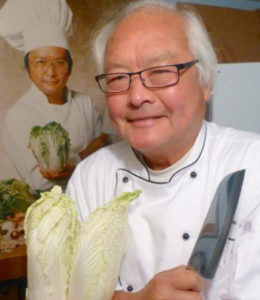Wok & Roll by Peter Kwong, (Frederic) Inter-County Leader
» Download this column as a Word document
I love cooking with mushrooms. Needless to say, the best part of cooking mushrooms is to feast on them when they’re ready.
In a heated skillet, add a few pats of butter, add some fresh chopped garlic and then whatever mushrooms you have. The flame and the sizzle will mesmerize you; and the sweet aroma of mushrooms getting sauteed — just how can one resist? Add a dash of wine with some salt and pepper to the skillet and close it with a lid, then just sit and wait for your steak getting done. What a life indeed. Virus … what virus?
There are many kinds of mushrooms in the market, and the most popular ones are white button mushrooms and portabella mushrooms. Crimini mushrooms are also available in some specialty stores, but they taste almost like their cousins, the white buttons, except a bit darker in color.
I found oyster mushrooms, abalone mushrooms and enoki mushrooms in the Asian grocery stores in Minnesota. They all have different colors, shapes and textures, but they all taste great. I have to admit that the abalone mushrooms are my favorite as they do taste like abalones. All I have to do is slice them bite-size and stir-fry them with a little sauce. Simple pleasure at its best.

My wife and I have tried porcini mushrooms in a fancy Italian restaurant once. It was nutty and meaty and was quite aromatic. However, the sauce was a bit overpowering.
When you dine out, you are at the mercy of the chef, as everyone has a different taste. So, what to do? I remember in one of my cooking classes, I made one of my favorite sauces and I gave each student a tasting spoon, and asked them to tell me what they think of it.
Two of the students claimed that it was perfect, while the rest all expressed their personal opinions. Some said the sauce needed more salt, some said it needed more sugar, and some said that more wine would enhance the flavor. So, I smiled and told them that I was trying to make a point, i.e., that’s why we need recipes.
After you make a dish by following the recipe, it is your decision to determine what the final flavor should be — to please your own taste or your guests? Ah, the power of the chef!
Back to mushrooms. I’ve seen chanterelle mushrooms and morel mushrooms, but I’ve yet to have the privilege to try either. We were at my son’s house, and he told me he had something to show me. He has a good friend who likes mushroom hunting, and he found those precious treasures. I didn’t have the heart to ask him to cook me some to try. It’s OK, I will find some of my own one day. I’ll have a mushroom feast then. I find mushrooms in our yard all the time, but I dare not pick and try them; my wife grew up on a farm, and she knows what is good and what’s not good for a city boy like me.
I’ve heard about the world’s most expensive mushroom — the truffles. They are found in the wild in Italy and France, and trained dogs and pigs are employed to unearth them. A pound of truffles can fetch the price of 2,200 euros (equivalent to U.S. $2,400). Goodness, that’s $150 an ounce! I’ve seen pictures of the gem in a food magazine, and that the restaurant will shave off a thin slice to serve over a salad. Can you even taste it?
My wife got me a mushroom-growing kit for Christmas one year. Looking at the catalogue with all these beautiful mushrooms popping out left and right, I was so excited. I would have my own mushroom feast soon. However, after carefully following all the instructions, and patiently waiting for weeks, nothing happened, not even a tiny sprout.
So, I called the company for an explanation, and all I got was a recording — “Please give us your name and number and we will return your call as soon as possible. Thank you for your patience.” After three weeks of that nonsense, I gave up on my mushroom feast.
Then a new hope emerged unexpectedly. One of my students knew that I offer cooking classes at people’s homes. He asked if I could trade my class for a lesson in growing your own mushrooms. But of course, I said, with no hesitation.
His house is in Weyerhaeuser, a short distance from Rice Lake. Very easy to find, he said. A piece of cake, he said. A 20-minute drive was a long haul when we lived in Milwaukee; and the drive to his house seemed like an eternity.
We started the mushroom lesson right away. I never knew that there was so much involved in this simple project. First, you have to cut the logs, which is best from oak or maple trees. Then you have to place spawn (cultured fungus) into holes drilled in each log (with the help of the inoculate bolts). Then the logs have to be shocked (soak in cold water for 12-24 hours) to induce fruiting. While we were working, all I could think of was harvesting the shiitake mushrooms.
My buddy gave me 10 logs that were all ready to go. He told me that he was involved with a SARE (sustainable agriculture research and education) project for years and loved it. It started out in New England back in 2012, and has become a popular program with the local farmers.
It was a fair trade — I taught his family how to cook Chinese food, and I have a bunch of potential shiitake mushrooms for months to come. What a wonderful day indeed.
I don’t remember how I made it home with all those heavy logs in the trunk of my little car. But I did. After piling up the logs and hosing them down with cold water, I proceeded to build a stand so all the logs could rest on them vertically. All I had to do was to wait for the harvest.
After patiently waiting for a week, I went to my “mushroom garden” and checked out the progress. My heart just sank when I saw that all the drilled holes that we painstakingly filled with spawn were left empty. Apparently, the woodpeckers in the area had been snacking on them. No wonder I hadn’t seen any of them in the bird feeders for days.
Well, at least someone is happy! Guess I’m stuck with dried shiitake mushrooms for a while. At least I don’t have to worry about getting logs for my fire pit; I’ve got logs waiting patiently on the side.



